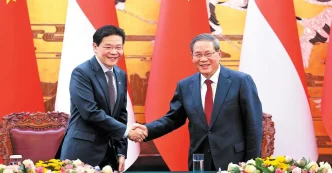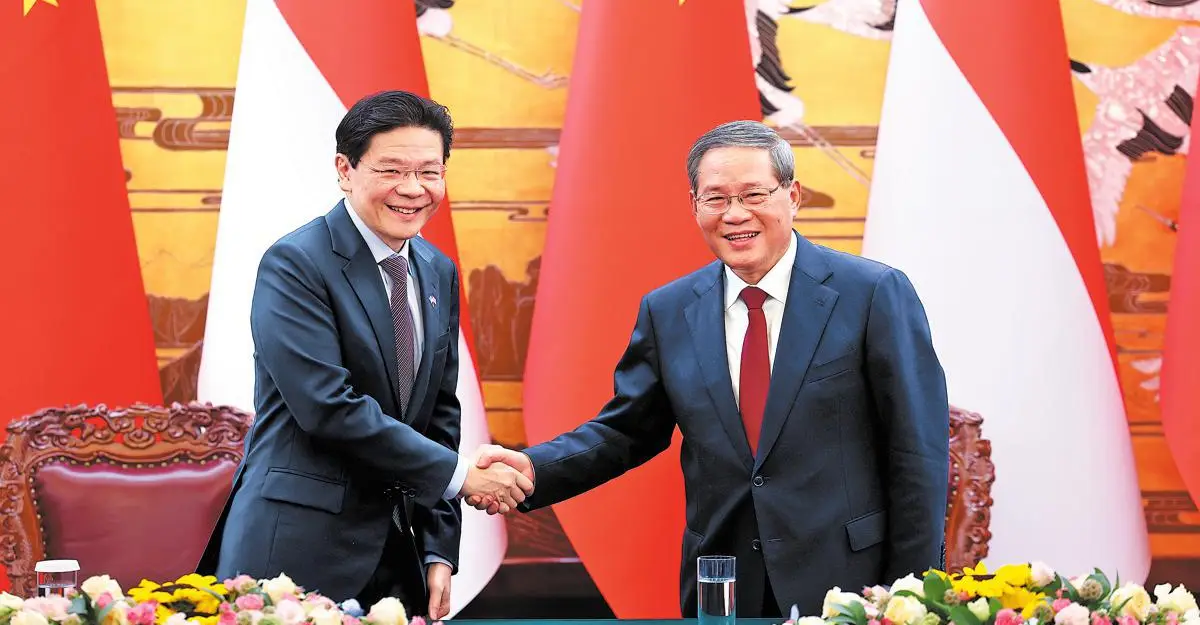In a significant step toward deepening bilateral relations, Singapore’s Prime Minister Lawrence Wong met with Chinese Premier Li Qiang in Beijing on June 23, 2025, marking his first visit to China since assuming office in May 2024. The meeting, held in the grandeur of the Great Hall of the People, underscored a mutual commitment to nurturing trust and expanding cooperation amid a turbulent global landscape. As the two nations celebrate 35 years of diplomatic ties, the visit signals a renewed focus on economic collaboration, regional stability, and multilateralism.
A Foundation of Trust and Respect
At the heart of the discussions was the importance of trust as the bedrock of Singapore-China relations. PM Wong emphasized the need to cultivate this bond across generations, stating, “The relationship between China and Singapore has continued to deepen and grow because it is a partnership built on a deep level of mutual respect, trust and understanding.” He added that this foundation “cannot be taken for granted” and must be nurtured continuously. His remarks reflect a long-standing tradition of close engagement between the two countries, dating back to the era of Singapore’s founding leader, Lee Kuan Yew, who prioritized strong ties with Beijing.
Premier Li echoed this sentiment, highlighting the significance of PM Wong choosing China as his first non-ASEAN destination for an introductory visit after the general election in May 2025. “This reflects the importance the new Singapore Government places on the China-Singapore relationship” said Li, signaling Beijing’s appreciation for the gesture. The visit, accompanied by a delegation of new and seasoned Singaporean officials, including Foreign Minister Vivian Balakrishnan and Acting Transport Minister Jeffrey Siow, demonstrated a commitment to building personal rapport and institutional links.
Navigating a Turbulent World Together
The talks took place against the backdrop of a world increasingly marked by uncertainty and instability, a point both leaders addressed with urgency. Premier Li noted that global “change and chaos” necessitate stronger cooperation between friendly neighbors like China and Singapore. He urged a united front to maintain open regionalism and defend economic globalization, particularly as tensions rise over trade policies, such as recent US tariffs aimed at curbing reliance on Chinese supply chains. According to state news agency Xinhua, Li called for efforts to “actively promote trade and investment liberalization and facilitation, and maintain the stability and smooth functioning of the global supply chain.”
PM Wong agreed on the need for collaboration, not only bilaterally but also through regional and multilateral platforms. “As you said just now, because we are living in a more uncertain and turbulent world, we should together find ways to cooperate” he told Li. This alignment on multilateralism and free trade reflects a shared vision for a rules-based international order, a principle both leaders reaffirmed during the meeting. Singapore’s Ministry of Foreign Affairs further noted that the discussions solidified their All-Round High-Quality Future-Oriented Partnership, with a focus on emerging sectors like the green and digital economies, as well as financial services.
Economic Optimism and Strategic Cooperation
A key highlight of the visit was the optimism surrounding China’s economic trajectory. Premier Li briefed PM Wong on Beijing’s ongoing reforms and its emphasis on high-quality development, a policy aimed at transitioning to a more sustainable and innovation-driven economy. In response, Wong expressed confidence in China’s long-term prospects, a stance that aligns with Singapore’s role as a major investor and trade partner in the region. The two sides also witnessed the signing of four agreements, including one on joint training for officials from ASEAN member states and Timor-Leste, which is set to join the regional bloc in October 2025. These agreements symbolize a broadening of cooperation beyond bilateral ties to encompass wider regional development.
The economic dimension of the partnership is particularly critical given the global challenges both nations face. Singapore, as a hub for trade and finance in Southeast Asia, has long benefited from stable relations with China, its largest trading partner. In 2024, bilateral trade reached record levels, with China accounting for a significant share of Singapore’s exports and investments. The focus on digital and green economies during this visit suggests a forward-looking approach to sustaining this economic synergy. For instance, joint initiatives in fintech and sustainable infrastructure could position both countries as leaders in these fields within the Asia-Pacific region.
Personal Rapport and Symbolic Gestures
Beyond the formal discussions, the visit was marked by visible signs of camaraderie between the two leaders. During the signing of bilateral agreements, PM Wong and Premier Li exchanged remarks directly without interpreters, a gesture that hinted at a growing personal connection. Li also hosted Wong to a welcome ceremony and a dinner banquet, traditional symbols of hospitality in Chinese diplomacy. These interactions build on prior engagements, including formal talks in Vientiane, Laos, in October 2024, and a brief meeting in Kuala Lumpur in May 2025 during the ASEAN-GCC-China Summit.
PM Wong’s itinerary in Beijing extended beyond high-level meetings. He visited the Beijing Humanoid Robot Innovation Centre, where he interacted with a bionic robot capable of mimicking human expressions, showcasing China’s advancements in technology. Additionally, he held a roundtable with Chinese businesses, reinforcing economic ties at the grassroots level. Reflecting on the visit via social media on June 23, Wong wrote, “I am confident that with continued trust and cooperation, the best days of the Singapore-China partnership are still ahead of us.”
Regional Implications and Future Engagements
The visit carries broader implications for Southeast Asia, where balancing relations with major powers like China and the United States remains a delicate task. Singapore has historically positioned itself as a neutral player, advocating for multilateralism while maintaining strong ties with both Beijing and Washington. PM Wong’s emphasis on regional cooperation during this trip aligns with this approach, particularly as ASEAN faces challenges ranging from South China Sea disputes to economic recovery post-pandemic. By strengthening ties with China, Singapore also reinforces its role as a mediator within the bloc, potentially facilitating dialogue on contentious issues.
Moreover, the focus on party-to-party ties and exchanges between government officials, as discussed by both leaders, suggests a deepening of political alignment. For Singapore, this could translate into greater influence in shaping regional policies alongside China, especially in areas like climate change and digital governance. However, analysts note that such alignment must be carefully managed to avoid perceptions of over-reliance on Beijing, particularly given domestic and international scrutiny of China’s growing assertiveness in the region.
Looking ahead, PM Wong’s meetings on June 24 with President Xi Jinping and National People’s Congress Chairman Zhao Leji are expected to further solidify these commitments. While specific outcomes of those discussions remain to be seen, the trajectory of Singapore-China relations appears poised for growth. The emphasis on mutual understanding and shared priorities—be it economic reforms or global stability—offers a blueprint for collaboration in an era of uncertainty.
A Partnership for the Future
As PM Wong concluded his engagements in Beijing, the message was clear: Singapore and China are not merely neighbors but strategic partners with a shared stake in each other’s success. The visit, rich in symbolism and substance, reaffirms a relationship built on decades of trust and mutual benefit. Yet, as global challenges mount—from trade wars to geopolitical tensions—the true test will lie in translating these commitments into tangible outcomes. For now, both nations appear determined to chart a path forward together, setting an example of cooperation in a fractured world.
As this partnership evolves, questions linger about how Singapore will balance its regional role with its global ambitions. Will deeper ties with China reshape its foreign policy, or will they reinforce its position as a bridge between East and West? Only time will tell, but for the moment, the foundation laid in Beijing offers a promising start to PM Wong’s tenure on the international stage.
















